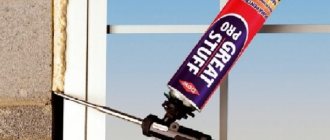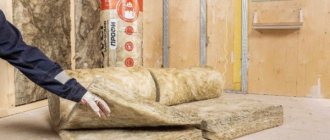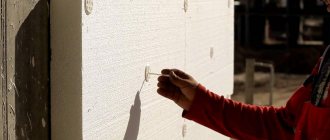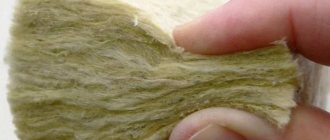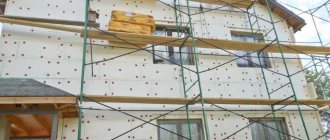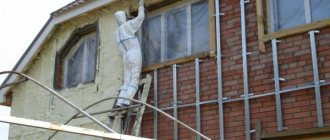Sasha built a frame extension to the house. I decided to insulate it with foam insulation. He built an extension because the old house did not have a hallway or a bathroom. The house was built in the 80s from brick.
Back then, our houses were built like this: brick walls with an air gap were built on the foundation. Then a roof was made, which was covered with slate.
A mixture of clay and flooring, 5-10 cm thick, was laid on the ceiling as insulation. To reduce heat loss at home, you need to insulate it. Then it will be possible to pay less for heating in winter and electricity in summer.
Summer in Kuban is hot and if the house is poorly insulated, the air conditioners will work almost around the clock.
When Sasha built the extension, he immediately decided that he would insulate the house and the extension with foam insulation. He saw on the Internet that guys were coming, drilling holes in the walls and pumping penoizol into them.
This is the best insulation option. If you insulate the house from the outside, you will have to make an additional façade. And this is a big expense.
I found through an advertisement the guys who blew foam insulation between the walls of an old house and into a frame extension. After 6 years, we had to dismantle the façade of the extension and when we saw what happened to the penoizol, then...
Although let me tell you about this a little later, for now I suggest you find out what penoizol is.
Features and Specifications
The installed foam insulation is a porous polymer mass.
The working solution is applied under pressure to the wall or ceiling, foams upon contact with air and hardens. Numerous gas bubbles provide thermal insulation and protect the premises from street noise and vibrations. Polyurethane foam, also known as polyurethane foam sealant, is a substance widely used in construction for fastening together individual parts of the connected structure, heat and sound insulation, sealing and filling voids that arise during the work process. Usually sold in metal cans, in which the foam itself and a mixture of liquefied gases are under pressure - the so-called. a propellant that serves as a buoyant force for the contents of the can. The versatility of this synthetic polymer makes it an indispensable assistant in many types of construction work and in almost any repair.
Of course, polyurethane foam sealant has its own characteristics and characteristics, which will be discussed below.
Scope of application
Foam insulation is considered a unique material, since its application in domestic conditions does not require special devices. Using foam, you can easily seal walls, windows and cracks in the roof of your home. The material is also suitable for insulating frame buildings.
Since foam insulation quickly hardens under the influence of the external environment and turns into closed-cell plastic, it is recommended for use for certain types of work.
- Installation and connection of various structural parts . This applies not only to the fastening of frame elements, but also to the installation of garage doors, door and window blocks.
- Isolation of inter-wall space from noise and sounds . This mixture can also be used to insulate the ceiling of a country house or apartment, the installation site of hoods and air conditioners.
- High quality thermal insulation . Foam is used to insulate loggias, balcony structures, garages and hangars. The material is also suitable for insulating facades.
- Sealing . Often the foam mixture is used to repair bathtubs, sealing passages, joints of pipes and engineering systems. Technical voids are filled with material, due to which communications last longer.
High-quality insulation in cylinders: features of polyurethane
PPU is one of the most popular types of thermal insulation materials produced in cans. What else do you need to know about him?
Features and properties of polyurethane foam:
- The qualities of this insulation directly depend on its composition and the additives it contains;
- Using polyurethane, you can quickly and without much difficulty insulate a structure of any configuration;
- This material is not afraid of the chemical effects of alkali or acid, and is able to withstand dampness and is too tough for insects and rodents.
True, as an option you can use “Ekopen” - one of the varieties of polyurethane foam. With its help, you can safely insulate walls and roofs, and with increased vapor permeability. Eco-foam will perform well when insulating ceilings, attic or interfloor ceilings.
But it should be borne in mind that the use of Ecopen is not intended for external insulation of a building without a protective coating, since it is a rather sensitive material to the effects of precipitation and mechanical loads.
What is the best way to insulate a building with foam - from the outside or from the inside?
It is difficult to give an unambiguous answer to this, but we will try to do so. One of the varieties of liquid foam, penoizol, is used for thermal insulation of frame buildings . This material fills the air gaps between:
- external and internal walls;
- wall and plastic panel;
- a wall and a sheet of drywall;
- subfloor and floor covering.
Insulation outside and inside
Using polyurethane foam, slabs made of solid thermal insulation materials are fixed, and the seams between them are also filled with foam.
Some homeowners use foam to insulate the facade of their building.
Polyurethane is used to eliminate minor defects on walls.
Stages of roof insulation with polyurethane foam
When applying the coating, you must follow the technology and sequence of work
Necessary tools and protective measures
To work you will need:
- reusable and or disposable spraying installation;
- mounting knife for cutting rolled and sheet materials and removing frozen excess foam;
- measuring tool for marking surfaces;
- painter's protective overalls with a hood and elasticated arms;
- tight shoes;
- safety glasses or face shield;
- respirator;
- gloves.
Preparatory work
During preparation, it is necessary to clean the surface to be treated from debris, dirt and remnants of old coatings.
Next, install the sheathing and metal profiles or wooden slats. Their thickness should match the planned thickness of the applied foam layer. In the future, the finishing trim will be attached to this frame.
The working solution is thoroughly mixed to the consistency required in the instructions.
Spraying material onto the base
The first layer of foam is applied to the prepared base. It is necessary to achieve a continuous application, closing gaps and filling uneven areas.
Spraying is done from top to bottom. If necessary, after the first layer has hardened, apply the second and subsequent layers. Each time you need to let the previous layer dry and set.
Excess insulation is cut off with a mounting knife flush with the installed sheathing.
If you plan to cover the insulation with a layer of plaster, a polymer or metal reinforcing mesh is mounted on the sheathing.
Application of fire retardant composition
Polyurethane foam is highly flammable and releases toxic substances when heated and burned. Therefore, the insulation layer is coated with a fire retardant compound. The composition must be selected specifically recommended for use together with polyurethane foam. It would be wise to choose it from the same manufacturer as the main material. The layer is applied with a sprayer or roller so that the coating is continuous and the entire insulation is protected.
Myths about the dangers of foamed plastics
Conspiracy theorists and unscrupulous advertisers of competing classes of insulation products often spread rumors about the terrible health risks caused by foamed plastics.
If you look at it without hysterics and exaggeration, polyurethane foam actually has one property that carries a potential threat.
When burned, it can form toxic volatile substances based on formaldehyde resins. During a fire, this may be an additional risk factor for those who did not have time to leave the burning premises.
During application of the foaming composition, some inert gas and other chemical compounds are also released.
However, after the foam coating has completely hardened for the entire period of its operation, no harmful emissions occur. The complete film surrounding each microcell is chemically inert and impermeable.
To summarize, we can say that the foam coating is completely safe during operation.
During application, all precautions specified in the user manual should be observed:
- use only serviceable equipment;
- exclude the use of open fire and high-temperature heating devices during application;
- use personal protective equipment: respirator, gloves, protective overalls with a hood and thick shoes;
- When working indoors, ensure ventilation
- do not use the premises for people to stay in them until the composition has completely hardened (usually 24 hours.)
Application
After about 30 cm, stop and see what layer of foam forms. If necessary, apply a little more foam on top of the first layer.
Over time, you will develop an understanding of the optimal amount of solution to spray.
But for pouring, it will be very problematic to correctly distribute the foam evenly throughout the entire space. The fact is that, in theory, you should first pour in the liquid, and then it, expanding, gradually becomes foam.
But the catch is that it is almost impossible to perform this procedure, since you cannot see what is happening inside. That is why it is recommended to install the hose in such a position that it points straight down, and then start pouring. So, the liquid will first fill all the cracks and niches from below, after which, expanding, it will move upward.
Material characteristics
Polyurethane foam (PPU) looks like a homogeneous structure of foam material, consisting of air bubbles filled with gas. Various versions of polyurethane foam are deservedly popular because they can be manufactured directly on the construction site. The most common method is to apply the material to the surface by spraying. Spraying is used for thermal insulation of houses, industrial workshops, pipelines, and in addition, it is actively used in the interior of premises.
Filling is used when it is necessary to fill a cavity between walls or a gap between installed finishing layers.
The thermal conductivity coefficient of the material is 0.023-0.025 W/mS. Teplis heat insulator is lightweight and can be easily applied to surfaces made of any materials (concrete, brick, glass, wood, aluminum, PVC).
Thanks to the optimal ratio of open and closed cells in the structure, the insulation “breathes”. Accordingly, the treated surface always remains clean and dry.
Other product benefits include:
- resistance to temperature changes;
- environmental friendliness;
- duration of operation (at least 20 years);
- seamless application, eliminating the formation of cold bridges;
- good sound insulation;
- low flammability;
- immunity from harmful rodents and insects.
Teplis polyurethane insulation is sold in 1 liter cylinders. Included with this product, the manufacturer offers to purchase a mounting gun with nozzles for uniform spraying.
Basement of a house with sprayed insulation applied
Conclusion
Foam insulation can be used for walls made of various materials, including aerated concrete, blocks and reinforced concrete panels. Therefore, they are used for insulation of private cottages and apartments. Before giving preference to any one type of foam, consult a specialist.
If you have decided to insulate your house with liquid foam, this is the right intention. Always try to buy raw materials from the best domestic and foreign manufacturers. This way you will be able to avoid premature wear of structures.
Features of insulation of various structures
Depending on the surface being treated, the order of the measures taken may be different. The advantage of polyurethane foam insulation is that it can be used for both horizontal and vertical elements. Insulating a house with foam has a high degree of adhesion to the surface, since the material penetrates into the most inaccessible places.
Insulation of floors
Can be done both from below and from above. For flooring above a cold basement, the most appropriate option would be to insulate the floor from below. Polyurethane foam is practically the only insulation that is convenient to work with in these conditions. To protect the attic floor, polyurethane foam is applied from the cold attic side.
Waterproofing and vapor barrier are not required during operation. It is recommended to carry out installation in the following order, regardless of whether insulation is performed from above or below:
- removing dirt and dust from the surface being treated;
- to increase adhesion, you can treat the surface with a primer;
- nailing slats or profiles, installing floor joists, between which heat insulation is sprayed;
- filling the space between the profiles with expanded polystyrene;
- finishing the ceiling or installing a clean floor.
Wall insulation
Insulation of walls with foam can be done from the outside and from the inside. External thermal insulation would be a smart solution, but if necessary, internal work is allowed, for example, with additional insulation after the facility is put into operation. The only differences are in the finishing.
The work is performed in the following order:
- surface preparation, cleaning from dirt and dust;
- marking the wall and installing vertical sheathing;
- filling the space between the frame with foam;
- installation of the facing layer.
Mansard roof
Insulating the space between the rafters with foam will allow you to choose the pitch of the rafters regardless of the dimensions of the material, as is the case with mineral wool. The insulation is installed in the following order:
- installation of elements of the rafter system and roofing;
- cleaning the base;
- spraying polyurethane foam between the rafters from the eaves to the ridge;
- installation of sheathing;
- ceiling cladding, such as plasterboard.
At what stages of construction is it better to pour polyurethane foam into the space between the walls?
It is possible to carry out insulation with liquid polypropylene foam at any stage of construction and even during operation. If you use roll insulation, then their use is simply impossible. Filling with ecowool, expanded clay, and other fill-in insulation materials is possible only with additional work to dismantle the wall. The method of pouring polyurethane foam into an open cavity is easily accessible at the construction stage. The already closed filling goes through special holes.
How to prepare for the insulation process
The preparation process is divided into three stages:
- surface preparation;
- preparation of equipment;
- preparation of components.
Kinds
It's no secret that modern insulation manufacturers offer the widest range of sealants to choose from. Let's together try to understand the abundance of types of polyurethane foam and see which types of the required substance will best serve a particular purpose.
Polyurethane foam differs in several ways.
Type
Household
Pros: no special equipment is required to work with household foam. It can be easily distinguished from a professional one by the external type of can: at the end of the container there is a special valve on which a lever with a plastic tube is attached.
Cons: can only be used to fill small voids or cracks; it is not used for installation, since it almost always requires trimming - the volume of this type of sealant is usually higher than the volume of the space it fills.
Professional
Pros: higher coefficient of primary expansion than the previous type, increased elasticity and finer structure. The supply of material can be controlled, so it is placed more accurately than household material, evenly filling the required volume. It is also impossible not to mention that professional polyurethane foam can be easily attached to almost any surface.
Cons: A nail gun is required for a professional look. However, given the versatility and wide scope of application, this minus is very relative.
By temperature of use
Summer
Summer polyurethane foam is recommended for use at positive temperatures – from approximately +5 to +30. At low ambient temperatures, the yield of useful substances from the can decreases, and the degree of expansion drops significantly. Work at elevated temperatures should also not be carried out due to the characteristics of the prepolymer, whose viscosity in such cases is significantly reduced.
Winter
Typically used at temperatures from -10 to +40 degrees. However, there are some types of foam that allow you to work even at -20 - for example, Tytan Professional 65 sealant. After hardening, the winter type can easily withstand temperatures of seventy degrees. Suitable for a barrel in which any substance can be stored.
All-season (or universal)
In fact, it has almost the same temperature range as winter and is not always classified as a separate group. Work with it is carried out at temperatures from -15 to +30 degrees.
By the number of components in the can
One-component
It is quite widespread and has a relatively low cost. The polymerization reaction occurs with the help of water. The shelf life does not exceed one year.
Pros: low cost, ready for use immediately after purchase, easy to use.
Cons: short shelf life.
Two-component (structural)
Water does not take part in the reaction. It is replaced by a special component, which is located in a small hermetically sealed container inside the cylinder itself. Its cost is higher than that of a single-component one and, as a rule, it is sold in small-volume cylinders (usually 220 ml), because the solidification time of the substance after mixing the components is short and amounts to ten minutes.
Pros: neat filling of voids.
Disadvantages: high cost; when producing a polyurethane mixture, it is necessary to strictly adhere to the established proportions.
According to the degree of flammability
- Class B1 – fire-resistant and fire-resistant. It usually comes in a pink or bright red hue - dyes are added specifically so that when applied, the type of composition is immediately visible.
- Class B2 - self-extinguishing, as the name implies, it does not support combustion.
- Class B3 – combustible PPU foam with zero fire resistance. Reviews are mostly positive.
Advantages and disadvantages of this type of insulation
The undeniable advantages of the substance in question, which the manufacturer usually indicates on the packaging, include:
- high degree of adhesion - that is, its ability to firmly attach to many surfaces. The exceptions are Teflon, silicone, ice, polyethylene and oily surfaces;
- heat resistance (usually ranges from -45 °C to 90 °C);
- cured polyurethane foam is a dielectric (does not conduct electric current);
- fairly fast hardening speed - from eight minutes to a day;
- high moisture resistance;
- lack of toxicity (of course, after final hardening);
- a small percentage of shrinkage (no more than 5%) throughout the entire period of operation;
- chemical resistance;
- high strength;
- long service life of the material (up to half a century).
Also no less important characteristics are:
- The total volume of sealant output is calculated in liters and refers to the amount of foam coming out of a unit of container. This characteristic is affected by ambient temperature, humidity and windiness.
- Viscosity mostly depends on air temperature. Temperatures above (or below) certain limits specified for each type of foam will negatively affect the viscosity of the substance. This is bad for masonry.
- Primary and secondary expansion. Primary expansion is the ability of the composition to expand immediately after leaving the cylinder in a very short time interval (up to sixty seconds). In this short period of time, polyurethane foam sealant is able to increase in volume by 20-40 times. Secondary expansion refers to the ability of a synthetic polymer to expand for a long time before polymerization finally stops.
High-quality polyurethane foam has a pleasant light yellow or slightly greenish color; it does not flow down when applied to the surface and is even suitable for the roof. It is not eaten by rodents and insects, and does not harm the environment. When hardened, the substance turns into a durable, porous, seamless material that is quite moisture-resistant and has excellent insulating properties.
It is important to note that under the influence of solar ultraviolet radiation, this insulating material is subject to rapid destruction - first it darkens and then becomes brittle. Never forget to plaster the foam-filled area after it has hardened.
Otherwise, it may simply turn into dust.
Polyurethane foam is suitable for insulating a frame house. It will serve as a special air gap.
Experts' estimates vary, so let's try to draw a line and compare all the pros and cons.
Advantages
- The porous structure prevents the accumulation of steam inside penoizol.
- Significant service life - from 50 to 60 years.
- Prevents the colonization of microbes and rodents, does not rot.
- Not subject to spontaneous combustion.
- Resistant to hazardous environmental influences.
- Possibility of quick installation.
- Does not release toxic substances after hardening.
- Insulation can be done with your own hands.
Minuses
- It takes a long time to dry. Complete drying of a not too thick layer takes at least two days.
- During polymerization, harmful formaldehyde is released.
- Does not adhere well to dirty surfaces.
- If necessary, dismantling the coating is very difficult.
- During the cold season, working with this material becomes very difficult.
| Application thickness, cm | Price in rub. per cube, density 36 kg/m3 | Price in rub. per cube, density 53 kg/m3 |
| 3 | 450 | 800 |
| 6 | 900 | 1550 |
| 10 | 1500 | 2600 |
Insulation using ready-made sheets:
| Slab thickness. cm | Price in rub. for 1 m2 |
| 10 | 1200 |
| 15 | 1800 |
| 20 | 2300 |
Insulation by pouring method:
| Type of work | price, rub. for 1 m3 |
| Pouring on the object under construction or into existing holes | 1500 |
| Filling with drilling | 1500 200 per hole |
As you can see, foam is not an inexpensive method of insulation, but taking into account the subsequent savings on heating and the speed of application, it is possible to reduce the overall cost of building a building. In addition, the price may be partially covered when carrying out insulation work with your own hands.
Features of insulation
To independently insulate a house with foam, you need a protective suit. Foam is usually sprayed from a can onto the entire surface of the facade; it fills the voids between walls, rafters, and beams.
There are many advantages to this type of wall insulation with foam in the air gap. The main ones include:
- vapor permeability;
- fire resistance;
- ability to increase in volume;
- resistance to various types of mechanical stress;
- the upper temperature limit remains within +80 degrees.
Foam is often used to seal cracks that remain after installing plastic windows. Due to this, the thermal insulation in the apartment also increases. It is convenient to use a pneumatic gun for insulating not only windows and external walls, but also foundations, loggias and balconies, and pipes.
After treatment with foam insulation for walls, the facade turns out perfect - without visible joints or seams. One cylinder contains on average 600-700 ml of the composition, which is enough to treat a square meter with a layer up to eight centimeters thick. Operating such a gun is very simple: first, a full cylinder is inserted into it, then you need to point it at the surface to be treated and pull the trigger. On average, the applied composition hardens within 24 hours.
Useful video
Before starting construction of a building, it is necessary to carefully consider the issue of its thermal insulation. In this case, not only the walls, but also the entire structure should be insulated.
Today, the construction market is represented by a huge selection of thermal insulation materials, but foam deserves special attention. It allows for high-quality insulation, protecting the building from temperature changes, and provides a constant indoor microclimate at any time of the year.
Types of material and their properties
Foam heat insulators vary in their composition and application method
Liquid penoizol
This popular material is used to insulate floors and walls. It has the following advantages:
- high-quality adhesion to most building materials;
- small amount of preparatory work;
- seamless and jointless coating;
- good vapor permeability;
- high penetrating ability;
- possibility of filling hard-to-reach volumes;
- resistance to fungus, microorganisms and mold;
- environmental friendliness.
The material also has disadvantages:
- linear shrinkage;
- strong unpleasant odor during application;
- hygroscopicity, additional water vapor barrier is required;
- fire hazard; when heated, toxic substances are released.
Roof insulation can be done using liquid penoizol.
Penoizol requires an additional fire retardant coating; it is better to use it for external insulation of the roof of a house.
Polyurethane foam (PPU)
Closed-cell polyurethane foam insulation is also deservedly popular among homeowners. Experts highlight the following advantages inherent in the material:
- applicability over a wide temperature range;
- compatibility with most popular building materials;
- ensuring the tightness of the sprayed coating even with a complex roof configuration;
- low thermal conductivity coefficient;
- resistance to biological influences: mold, microorganisms, insects, rodents;
- low density of the material and, accordingly, a small additional load on the roof;
- resistance to solvents and other active substances;
- ability to withstand compressive and tensile loads;
- low vapor permeability, no need for additional vapor barrier;
- minimal hygroscopicity;
- excellent noise insulation performance;
- long service life comparable to the service life of insulated structures.
There are PPUs and a number of disadvantages:
- high activity of the working staff, harm to exposed skin and respiratory organs;
- the need to use protective clothing, masks and respirators;
- vulnerability to sunlight, especially ultraviolet rays, necessitates protecting the coating with an additional layer of mastic or plaster;
- releases harmful substances when heated;
- highly qualified worker applying the coating is required;
- high cost of equipment for applying the material.
The last two factors make it difficult to apply polyurethane foam yourself. Even disposable installations, already charged with a certain volume of working solution, are expensive. If the home owner does not have experience in successfully using them, it is better to turn to professionals and insulate the roof with their help. You will be able to save your nerves, money and time.
Operating principle of the equipment
Equipment for pouring polyurethane foam is divided into 3 categories according to the method of application.
According to this criterion, installations are divided that during operation perform:
- Low pressure.
- High pressure.
- Foam generators.
Models that operate at high pressure do not use compressed air during application.
Equipment of this type has a number of advantages:
- High performance.
- The dosage is accurate.
- Operation is simple.
- Mixing of components is carried out perfectly, which has a good effect on the quality of the resulting material.
- You can spray polyurethane foam in small portions.
- Due to the airless application method, the formation of fine particles in the room is minimized.
Disadvantages include difficulty in maintenance and high price of materials. Low pressure models use compressed air.
The advantages of such installations are as follows:
- Reasonable price for components.
- Easy to maintain.
- Simplified design.
Among the disadvantages, we highlight the high consumption of polyurethane foam and not entirely accurate dosage. And a separate category is the foam generator, which mixes components using air, which is supplied using special compressors.
Types of foam insulation
There are 3 types of foam:
- Assembly room.
- Polyurethane, consisting of 2 substances.
- Liquid polystyrene foam - penoizol.
Other types, the packaging of which clearly indicates the scope of application.
Polyurethane foam in cylinders
This is a one-component thermal insulator. Insulation can be carried out independently.
Types of polyurethane foam:
- façade – having a large temperature range. It can withstand minus and plus temperatures;
- ordinary - for sealing cracks, sealing seams;
- with special strength;
- glue-foam.
A construction gun is used to apply the material.
Penoizol
Penoizol is similar to polyurethane foam, but it has a different composition. It has a low level of density, does not allow cold, sounds, or moisture to pass through. It is most often used to insulate houses.
To apply the material you need equipment and dry, warm weather. After completing the work, it takes 5 days for complete drying, only finishing work is carried out with topcoat.
Spray polyurethane foam
Polyurethane foam consists of 2 substances. This is the best material for thermal insulation of a building. Cylinder equipment is used for installation. The material on the surface hardens within 10-20 minutes. The structure is closed cells that have minimal thermal conductivity, noise insulation, and moisture penetration.
One layer of applied material is 6 cm thick. Sometimes after complete hardening, a 2nd layer is applied for strength.
wall pie
Construction of a wall “pie” of a frame house:
- interior decoration;
- vapor barrier layer;
- insulation;
- frame stand;
- windproof layer;
- transverse lathing;
- vertical lathing;
- external finishing.
If you plan to insulate the premises from the inside, you need to carry out all the work in stages. One of the main issues that you should pay special attention to is the correct placement of the vapor barrier film in the thermal insulation “pie”.
Vapor barrier can be made from:
- reflective film;
- diffusion membrane;
- steam condensate film.
When installing a vapor barrier material, you need to take into account one important point: it must be mounted on top of the insulation on the room side. If you plan to insulate the wall with polyurethane foam, then you will not need a vapor barrier.
Is penoizol harmful to health?
After testing, Russian manufacturers were convinced of the safety of using penoizol. There are certificates confirming this. But polystyrene foam is prohibited in Canada and is not used in the USA as insulation. In the UK, safety guidelines are followed regarding the use of urea foam as a toxic substance. The problem lies in the concentration of formaldehyde, which is released during polymerization. At high concentrations in the air it causes allergies and tumors in the future
Therefore, it is very important to use high-quality materials and adherence to pouring technology. In high-quality products and in the hands of craftsmen, the minimum content of formaldehyde is safe
What is better - penoizol or polyurethane foam?
In order to understand which material is of the highest quality and strongest, it is necessary to compare them.
Thermal conductivity when installing installation insulation.
In this case, polyurethane foam takes first place, since its coefficient is higher than that of penoizol.
Density.
Foam also wins. Unlike penoizol, it is harder and has a structure of increased density.
Resistant to liquids.
Due to the high density of the PPU foam material, liquid does not allow liquid to penetrate into its structure; the first material, on the contrary, is prone to exposure to moisture and its absorption.
Resistant to fire.
Penoizol is a material that does not ignite at all, and foam is susceptible to melting and releasing harmful substances.
Life time.
In this category, both materials are equal; their optimal service life is about 50 years.
Price.
Penoizol is slightly cheaper than PPU foam.
Cutting off excess material for further processing.
Reviews
Recently, most builders have chosen foam as the main insulation material. They attribute this to the high performance characteristics of the material. Judging by the reviews, the foam is easy to install, so it can be used at home to insulate balconies or loggias. The material has proven itself not only as a heat insulator, but also as an excellent fixative . Therefore, most homeowners, when carrying out repairs, choose it for attaching door and window blocks.
Residents of apartments in multi-storey buildings, where not only heat but also sound insulation is important, are also satisfied with polyurethane foam. Thanks to its unique structure, the mixture adheres tightly to the surface of the walls and ceiling, reliably protecting them from the penetration of extraneous noise. In addition, many consider the main advantage of foam to be its strength and long service life.
Insulation process
Do-it-yourself foam coating is within the capabilities of a home DIYer with basic spray painting skills. When working with entry-level household installations, as a rule, one person can handle it. When installing sheathing and when working with high-performance devices with long hoses, an assistant will be required to carry them, as well as move containers with components.
Preparing to start work
Before you begin, you need to prepare the surface for coating. You should remove old wallpaper, paint and anything that might prevent the foam from adhering to the surface.
Next, in increments of 50 cm, vertical guides are attached to the wall - wooden blocks or a metal profile. They are designed for fastening finishing materials - drywall, lining or others. If there is no decorative coating, the guides are not installed and the foam is sprayed in a continuous layer.
All work on laying communications - electrical and pipelines - must be completed before spraying begins. It is recommended to lay wires in corrugated plastic or metal sleeves.
Before you start covering the wall with foam, you should also make sure that there are no air bubbles left in the hoses and cylinders.
Continuous wall covering
